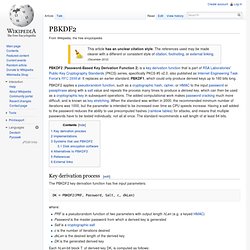

OpenSSL for iOS.
PKCS. In cryptography, PKCS is a group of public-key cryptography standards devised and published by RSA Security Inc, starting in the early 1990s.

The company published the standards to promote the use of the cryptography techniques to which they had patents, such as the RSA algorithm, the Schnorr signature algorithm and several others. Though not industry standards (because the company retained control over them), some of the standards in recent years[when?] Have begun to move into the "standards-track" processes of relevant standards organizations such as the IETF and the PKIX working-group. See also[edit] Cryptographic Message Syntax References[edit] General Jean-Sébastien Coron, Marc Joye, David Naccache, and Pascal Paillier, New Attacks on PKCS #1 v1.5 Encryption, EUROCRYPT 2000, pp. 369–381. [1]. External links[edit] RSA Security's page on PKCSWhat is PKCS? RFC 2898 - PKCS #5: Password-Based Cryptography Specification Version 2.0. [Docs] [txt|pdf] [draft-kaliski-pkc...]

[Diff1] [Diff2] [Errata] INFORMATIONAL Errata Exist Network Working Group B. Kaliski Request for Comments: 2898 RSA Laboratories Category: Informational September 2000 Status of this Memo This memo provides information for the Internet community. It does not specify an Internet standard of any kind. PBKDF2. PBKDF2 (Password-Based Key Derivation Function 2) is a key derivation function that is part of RSA Laboratories' Public-Key Cryptography Standards (PKCS) series, specifically PKCS #5 v2.0, also published as Internet Engineering Task Force's RFC 2898.

It replaces an earlier standard, PBKDF1, which could only produce derived keys up to 160 bits long. Key derivation process[edit] The PBKDF2 key derivation function has five input parameters: DK = PBKDF2(PRF, Password, Salt, c, dkLen) where: PRF is a pseudorandom function of two parameters with output length hLen (e.g. a keyed HMAC)Password is the master password from which a derived key is generatedSalt is a cryptographic saltc is the number of iterations desireddkLen is the desired length of the derived keyDK is the generated derived key Each hLen-bit block Ti of derived key DK, is computed as follows: DK = T1 || T2 || ... || Tdklen/hlen Ti = F(Password, Salt, c, i) The function F is the xor (^) of c iterations of chained PRFs. Java - How can I calculate the SHA-256 hash of a string in Android. PBEKey. PBEKeySpec Usage, Examples, Demos and Tutorials. Password Based Encryption Using AES (by Nurullah Akkaya)
In a recent engagement, I needed to encrypt an object then write it to disk.

I wanted to use Advanced Encryption Standard (AES), but unfortunately Java does not provide a way to use password based encryption with AES. Bouncy Castle does provide the required libraries that will allow us to use password based encryption with AES. In this scenario, I wanted the user to provide the pass phrase. import javax.crypto.SecretKeyFactory; import javax.crypto.SecretKey; import javax.crypto.SealedObject; import javax.crypto.Cipher; import javax.crypto.spec.PBEKeySpec; import javax.crypto.spec.PBEParameterSpec; import java.security.Security; import org.bouncycastle.jce.provider.BouncyCastleProvider; class seal { static String algorithm = "PBEWITHSHA256AND128BITAES-CBC-BC"; static char[] passPherase = "secretpass".toCharArray(); static byte[] salt = "a9v5n38s".getBytes(); static String secretData = "Very Secret Data!!
"; In real world you should generate the salt randomly. Encrypting the data, Key Derivation Functions: How many KDFs are there? Key derivation function (KDF) is a deterministic algorithm to derive a key of a given size from some secret value.

If two parties use the same shared secret value and the same KDF, they should always derive exactly the same key. Introduction | Glossary | Notation and Conventions | KDF1 | KDF2 | KDF3 | KDF4 | Examples of KDF | Password-Based Key Derivation Functions (PBKDF) | PBKDF1 | PBKDF-Schneier | PBKDF2 | Examples of PBKDF | References | Contact us Introduction There are at least four versions of KDF plus at least three password-based key derivation functions (PBKDF). Mask generation function (MGF) in some public key encoding schemes.
The difference between a KDF and a PBKDF is that a KDF uses a binary secret value to derive a key while a PBKDF uses a text password together with a salt and an. Examples of PBKDF.